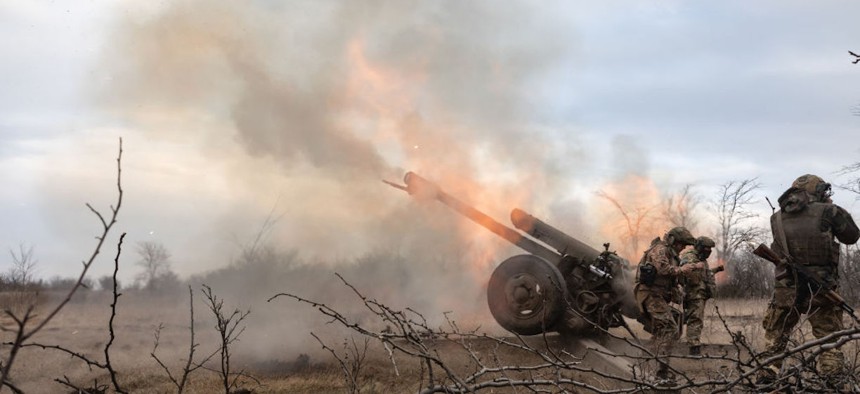
Artillerymen from the 24th assault battalion shooting from 122 mm howitzer D-30 into Russian positions near Bakhmut, Ukraine, in March 2023. Photo by Mykhaylo Palinchak / SOPA Images / LightRocket via Getty Images
Army aims to make 1 million artillery shells a year, starting in fiscal 2025
New manufacturing techniques helping U.S. ramp up production of critical munition need.
New manufacturing techniques are moving the Army toward its goal of producing 85,000 155mm artillery shells per month, starting in fiscal 2025, the assistant Army secretary for acquisition said Monday.
The push is meant to help Ukraine keep up the pace of its counteroffensive and to replenish depleted U.S. stockpiles and even help other countries build up their own supplies after the Ukraine war highlighted the importance of the munition in large-scale conflict.
“Between supporting Ukraine, replenishing ourselves and supporting other countries, allies, we expect to use that capacity. That's the overall reason we're doing it,” Doug Bush told reporters.
“You do the math on the [roughly] 80,000-a-month. I mean, that's a million a year,” he said.
The United States isn’t the only country working to supply Ukraine with 155mm shells. But as Ukraine battles a much larger force, one now dug in behind heavily fortified lines of defense in the country’s east, its artillery units are burning through the munition faster than it is being replaced. Ukrainian gunners are also wearing out the firing tubes on their howitzers at a rate never before seen, which has forced the United States to send cluster munitions as a “bridging capability,” Defense Secretary Lloyd Austin said in July.
Artillery shells are less complicated than many weapons developed for or consumed in the conflict, but the United States and other allies have struggled to increase production capacity. The challenges start with creating new lines to make the munitions’ metal components, Bush said.
“Then you also have to be investing in additional—what's referred to as load assemble pack capacity, which is filling the shells with explosives so they now become functional weapons. That capacity expansion is also underway at at least two locations. And then the final piece is bringing in additional production, either overseas or domestically, for the charges that go behind the shell...for the propellant that actually shoots that out of the cannon. Those require additional production of the explosives that goes in those propellant materials, called triple base propellant. So all of those things do have to come together…I think we're getting the resources, getting on contract and just working really closely every day with our industry partners to help them knock down barriers to get there,” he said.
Bush said new computer-assisted manufacturing techniques are helping to reduce complexity and time in manufacturing the new shells. For instance, shell production in the past required workers to heat metal and then just bang it on it to fold it into the proper shape. New techniques use rotary machines to produce casings faster with less energy and heat.
“Those things have been enabled by just more precise computer controlled equipment. So this is advanced manufacturing coming to artillery shell production” to add precision and consistency, he said.
The United States will also be increasing production of more sophisticated munitions that have proven their worth on Ukrainian battlefields. Among them is the Army’s month-old LASSO, for Low Altitude Stalking and Strike Ordnance, which are drones that loiter in the air and crash into their target once detected..
“On the UAS side, I think in some cases, yes, what we're sending to Ukraine is also going to fit into our future plans. So we are initiating a new program or to provide infantry units primarily with a loitering attack munition,” Bush said.




